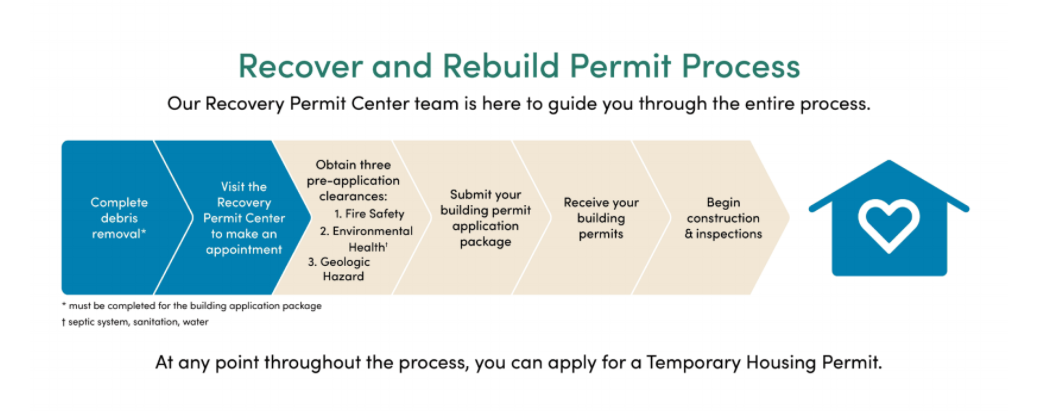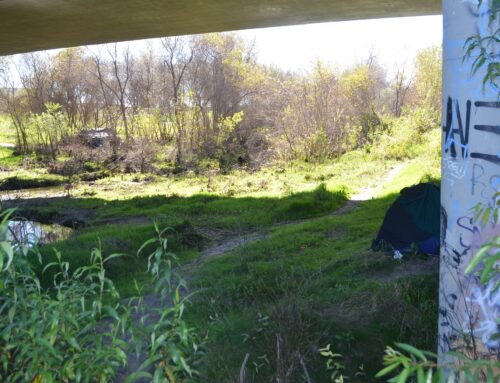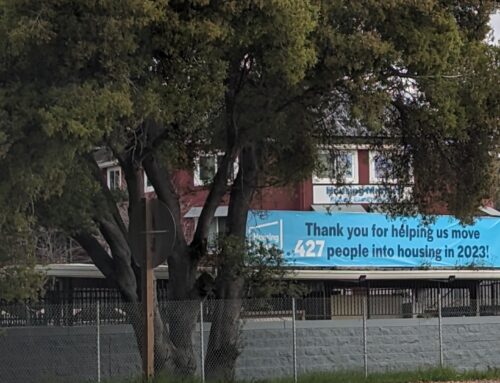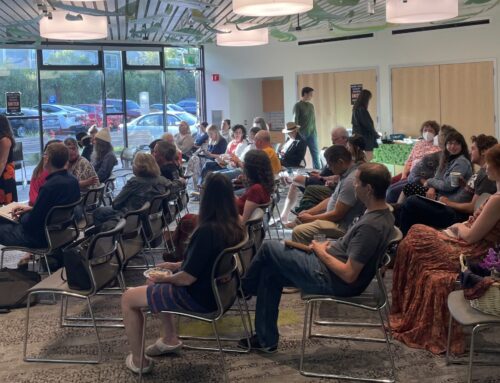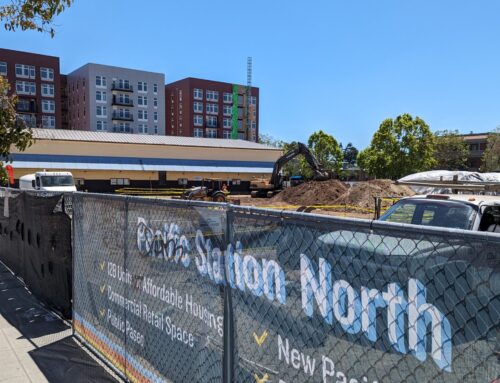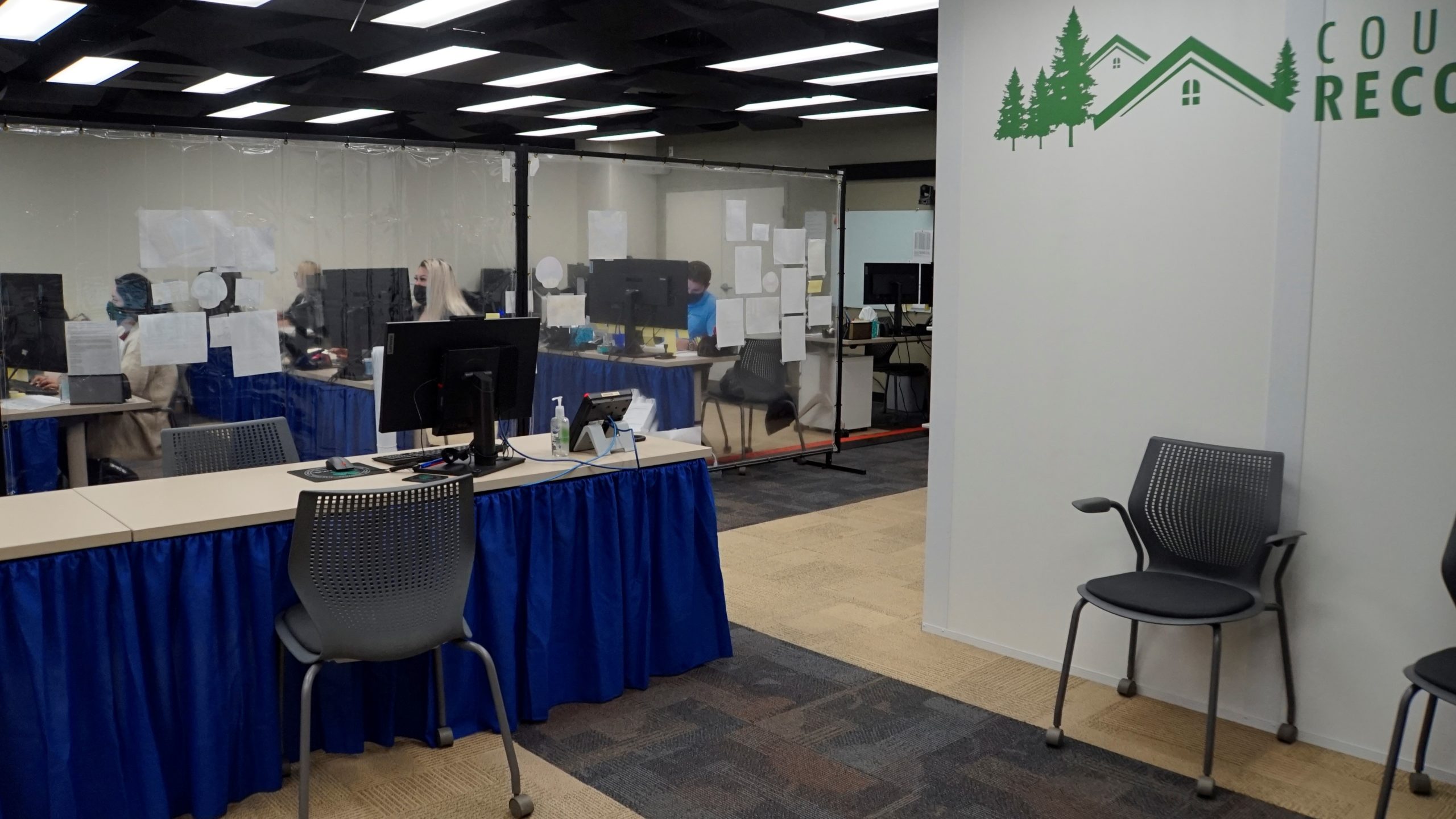
Four workers handle building permit processing for CZU Lightning Complex Fire survivors Tuesday at the County of Santa Cruz Recovery Permit Center in the basement of the county government building in Santa Cruz. (Kara Meyberg Guzman — Santa Cruz Local)
SANTA CRUZ >> Spurred by many North Coast and San Lorenzo Valley residents who await permits to rebuild homes lost in the CZU Lightning Complex Fire, the Santa Cruz County Board of Supervisors on Tuesday discussed how county staff could speed permit evaluations.
Waiting for permits
Almost a year after the CZU fire destroyed more than 900 homes on the North Coast and in the San Lorenzo Valley, many survivors still await permits to rebuild as deadlines on insurance payouts near.
“We can’t delay much longer. People are on a timeline,” Supervisor Ryan Coonerty said. “Finances are limited and the trauma is still impactful.”
Tuesday, county supervisors unanimously voted to work on a plan to speed building permits for CZU Lightning Fire survivors by Sept. 14. Staff from the county’s Planning Department and the Office of Response, Recovery and Resilience were directed to bring forward proposals ranging from changes to the county code or General Plan or other steps that would allow CZU fire survivors with homes in geologically hazardous areas to get the green light more quickly.
Santa Cruz County’s process to issue rebuilding permits for CZU Lightning Complex Fire victims requires a geologic hazard evaluation. Nearly a year after the fire, many residents still wait for rebuilding permits. Click the image for details on steps to get a permit. (County of Santa Cruz Recovery Permit Center)
The process
The County of Santa Cruz Recovery Permit Center, created to help CZU fire survivors, uses a pre-application process to clear projects. It usually takes about two weeks for county staff to process the applications and come to a determination, Acting Planning Director Paia Levine told supervisors.
- The first step is a review of maps and a free consultation with the county geologist to gauge risks for debris flow and mudslides. Levine said “the vast majority” of projects don’t have significant geological hazards and are able to move through that step.
- Levine said 259 households have received pre-application clearances.
Coonerty and Supervisor Bruce McPherson aim to expedite the pre-application geologic hazard evaluation. Their districts include the CZU burn zone.
Those evaluations could come with “extensive” requirements to meet code “at levels that are entirely unattainable by many survivors, especially those who are underinsured or uninsured,” Coonerty and McPherson wrote in Tuesday’s agenda report. “These constituents are already at risk of using up all of their insurance proceeds and may end up living on their land in RVs, tents, or other temporary housing accommodations longer than intended as a result.”
Under the county’s decades-old geologic hazards regulations, floods, landslides and fault lines that existed long before the CZU fire could be barriers to rebuilding.
“We have to make this practical and realizable and we have to do it soon, because the insurance money doesn’t last forever,” said Karen Vitale, whose son lost his home in the fire and has not been able to receive geologic pre-clearance.
The regulations allow the planning director or elected officials to waive certain requirements if enforcing them would cause significant public health, safety or welfare issues.
“We have to remember these are potential hazards, not certain hazards, and some of them may never come to pass,” McPherson said.
The board’s decision Tuesday asks county staff to find ways to allow CZU survivors to rebuild without evaluations and requirements related to geologic hazards that existed before the fire.
In June, the board conceptually approved a request by the county planning department to allow rebuilding permits to be issued prior to a geologic evaluation. The board was scheduled to decide on the details this month, but the effort has been delayed until the fall as county leaders await a study to gauge flood and debris flow risk.
Update on county’s three-year plan to address homelessness
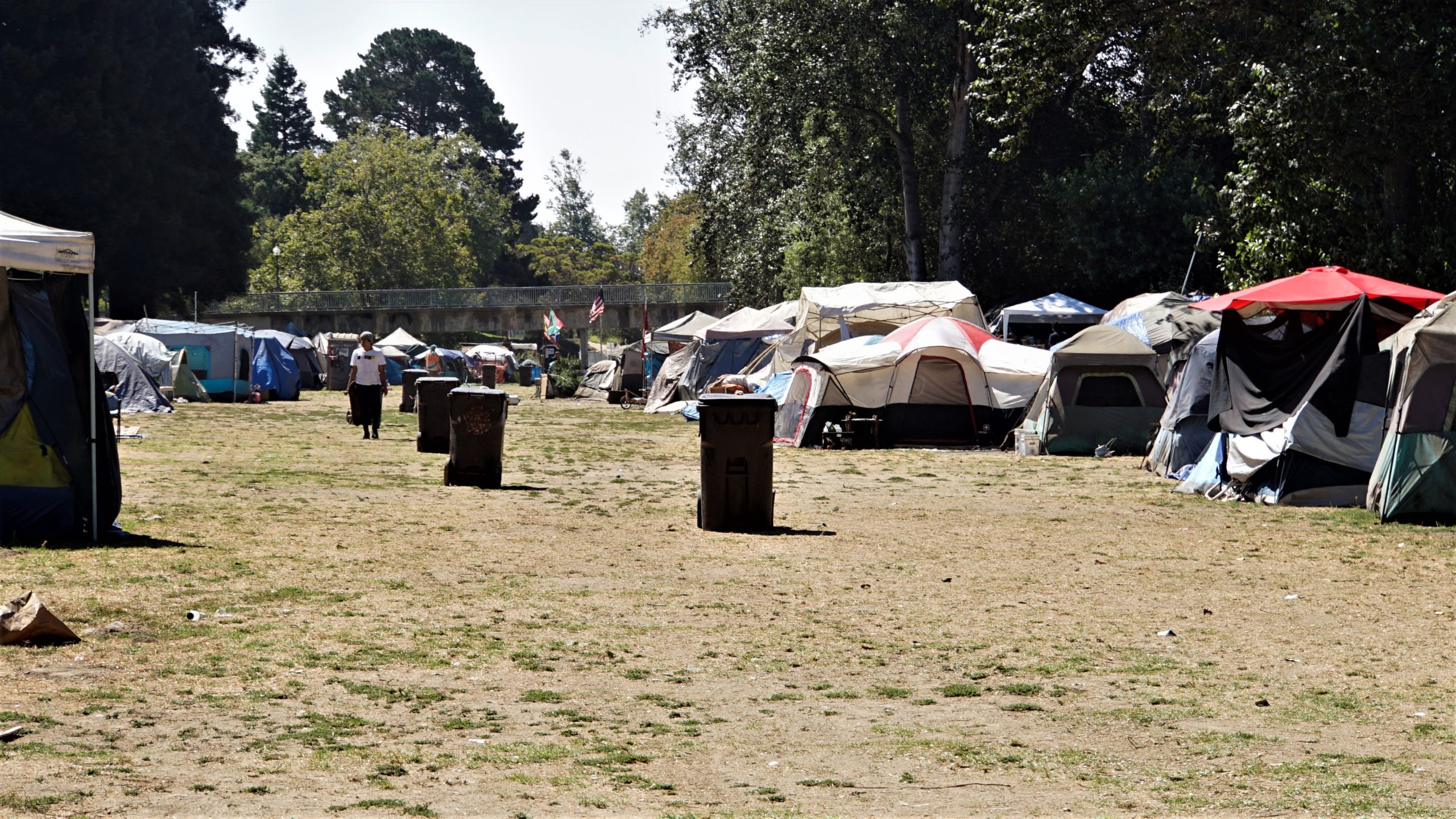
Dozens of tents lined the benchlands in San Lorenzo Park on Aug. 10, 2021. The City of Santa Cruz has managed a homeless camp there for months. (Kara Meyberg Guzman — Santa Cruz Local)
Tuesday, the supervisors also heard updates on the first six months of a three-year plan to address homelessness in Santa Cruz County. The Housing for a Healthy Santa Cruz Framework approved in March sets a goal of reducing the Santa Cruz County households experiencing unsheltered homelessness by half, and reducing overall homelessness by 25% by 2024.
Between July 2019 and June 2021, there were an estimated 2,300 to 2,400 households experiencing homelessness in the county, said Dr. Robert Ratner, the county’s Housing for Health director.
Temporary shelters end soon
While the county was able to create at least 370 new shelter units in 2020 thanks to pandemic-related funding from the state and federal government, one-time relief money is expected to end soon. Funds from the Federal Emergency Management Agency will expire on Sept. 30, and the county’s COVID-19 shelter operation will scale down by December, he said.
As of July 25, about 270 to 300 people lived in temporary shelters that opened in Santa Cruz County during the pandemic.
Ratner said his immediate focus is to rehouse those in COVID-19 shelters and find sustainable and timely ways of reaching, sheltering and housing the homeless in coming years.
Approaches could include:
- Use of federal dollars to purchase properties instead of relying on openings in the “tighter than tight” private housing market, Ratner said.
- Creation of new shelters or safe parking sites on vacant lots throughout the county. County staff identified 340 publicly-owned parcels in unincorporated areas of the county that potentially could be used for emergency shelter. Sites have not yet been named.
- Estimated start-up costs for emergency shelter for 120 households range from $120,000 for six safe parking sites to $72 million for 120 low-barrier units with services, staff wrote in Tuesday’s agenda report. Annual operating costs could range from $1.7 million to $4.3 million.
- Real estate partnership programs to incentivize homeowners and landlords to rent vacant units to people without housing.
- A strategy to add more flexibility with use of Housing Choice Vouchers — also known as Section 8 vouchers.
- Search for grant funding for the construction or purchase of new shelter facilities and operation costs.
Rent money
Preventing homelessness — instead of responding after-the-fact — will be a top priority in the next six months, Ratner said, especially by connecting residents with underused rental assistance and other resources.
For example, about 20% of the nearly 4,000 eligible Santa Cruz County households have applied for rent money from California’s Housing Is Key program, according to an Aug. 6 statement from Community Bridges, a nonprofit partner of the County of Santa Cruz for the rent relief program.
Homeless children

The Santa Cruz County Office of Education’s definition of homelessness includes students who are “doubled up” in shared housing due to economic hardship. More than 4,700 Santa Cruz County students were considered homeless in 2018-2019. (Source: Santa Cruz County Office of Education | Graphic: County of Santa Cruz)
County leaders previously set a goal that by December, no family with children will be unsheltered for more than 90 days.
- In 2018-19, Santa Cruz County had 4,749 homeless students, according to data from the Santa Cruz County Office of Education. Most of those children shared housing in South County with other families due to housing loss or economic hardship.
- The county has shelter space for 70 families with children. Shelter space is needed for about 30 to 70 more families, staff wrote.
- Estimated cost to build a new family shelter would be $6 million to $42 million, with an annual operating cost of $876,000 to $2.5 million. Funding has not been identified.
Developing affordable housing, and specifically housing units for people with very low incomes, could also help address homelessness, county leaders said.
Supervisors are scheduled to receive another update on the homelessness framework in February.
Santa Cruz Local’s Kara Meyberg Guzman contributed to this report.
Become a member of Santa Cruz Local, an independent, community-supported newsroom that’s owned and led by local journalists. Our stories are free and always will be, but we rely on your support.
Already a member? Support Santa Cruz Local with a one-time gift.
Isabella Cueto is a bilingual journalist. She has covered a wide variety of local issues in Santa Cruz County, as well as South Carolina and South Florida.

